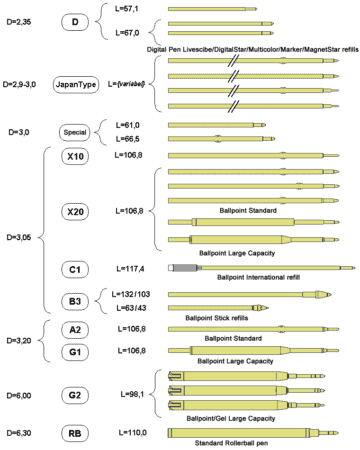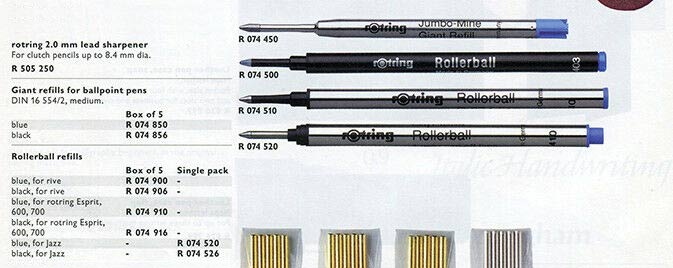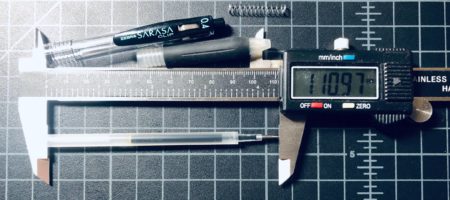Pen refills come in a wide variety of shapes and sizes. Some of these are standards, shared across pen brands and decades of pen designs, while other are propriety and limited to just a few brands or even a few models. This means that replacing the ink in a pen, especially an older one, may end up being a more difficult task than you’d expect.
The goal of this article is to make buying a new ink refill for your pen as easy as possible. A secondary goal to this guide will be maximizing the number of refill options available for each pen. This is only possible once you have a good understanding of refill shapes and which are interchangeable.
Pen Refill ISO Standard
Many pen refills adhere to ISO standard 12757 and the later revision ISO 12757-1:2017 which is set by the International Organization for Standardization. This isn’t something that’s mandatory — custom and proprietary refills certainly aren’t illegal — but for practical purposes if you are making a certain refill type, it makes sense that yours is the same dimensions as that of the other manufacturers.
The standard has two main components: one for general use and one for “documentary use,” which is basically a stricter standard. This latter application is ISO 12757-2, and it covers the legibility of letters as well as writing for archival documents.
Most refills in this guide were defined by ISO standards 12757-1 and 12757-2. These documents are not freely available, nor are they cheaply obtained. It can be purchased for about $65, which is not practical for most hobbyists.
Pen Refills Compared
Here is a visual representation of some of the many ISO standard pen refills. It mostly displays ballpoint pens, but rollerball, gel, and hybrid refills could take these shapes as well.

Reading the diagram:
- The leftmost column of the image is a refill’s diameter in millimeters. For example D-6,00 means a refill is 6.00 mm in diameter.
- The circled item is the name. G2 is the name of a specific ballpoint pen refill specification.
- Next is the length in millimeters. L=98,1 means a is spec’d to be 98.1 millimeters long.
- Finally there is an image of refill in profile. A true technical drawing of each refill would have many more measurements, as there are very exact specifications for every refill, but this will give you some idea of what each refill looks like.
This can be used as a handy visual guide and will be useful if you happen to have a refill you are unable to identify.
ISO Standard Pen Refill Types
Here are a few popular refills that adhere to ISO standards with an explanation of each.

D1 Refill
The D format, commonly known as the D1, is a small refill usually seen in multi-pens and mini-pens. Unlike some of the other standards in this list, the D1 remains a very popular refill to this day. D1 refills usually made of metal, but they can also be made of plastic.
And oddity of the D1 refill is that is comes in two different widths. This means that not all D1 refills will fit in all D1 pens. Most Japanese manufacturers use the thinner design while German manufacturers tend to use the thicker one.
- Example Refill: Schmidt Easyflow 6000, Uni SXR-200, Kaweco Soul
- Dimensions: 67 mm long, 2.1 or 2.35 mm diameter

A2 Refill
The ISO 12757-2-A2, commonly known as the A2 format, consists of a slim, metal cylinder with a very thin writing tip. It was mainly used in retractable ballpoint pens before the 1990s. This refill is rarely seen any more as it’s largely been replaced with proprietary refills and plastic parts.
The very thin writing tip is the most important feature here, as pens that use the A2 will often have a tiny window that the tip extends through. This small aperture means something like the X20 refill will not work.
- Example Refill: Schneider Express 75 M
- Specs: 106.8mm long, spring shoulder 33.4mm from the tip of the pen, 3.2mm diameter

B3 Refill
The B3 is no longer a common refill, but you might know it because it looks exactly like the refill used in a Bic Cristal. This refill is almost always seen in a plastic body and plastic cone at the front.
- Example Refills: Pokka Pen refill, Bic Cristal
- Specs: 128 mm long (typical, length can vary)

C1 Refill
A C1, or Cross style refill, is a screw-type refill that is almost always used with twist retractable pens. The refill (almost always) has a metal body which is a long, thin cylinder. On the top of the cylinder is a plastic piece which can be screwed into the pen body but is press-fit onto the refill.
The metal cylinder is usually replaceable where the plastic top is part of the pen. The advantage to this is that the metal component can be taken from a compatible refill that does not use a standard part on top.
This refill is quite similar to the A1 but it is held in place with the top piece, not the “wings” in the middle of the refill.
- Example Refill: Cross Ballpoint refills
- Specs: 117 mm long, 3.05 mm in diameter

G2 Refill
The ISO G2 refill, usually known as a Parker-style G2 refill, is one of the most common and versatile pen refills ever sold. It’s still popular today with pens in all price ranges. This refill size is sometimes known as the “Standard International Ballpoint” refill, but it’s no more standard than anything else in this section.
The G2 refill was originally used with ballpoint ink, but has been designed to also accomodate hybrid and gel inks. The refill is commonly seen in metal, but some manufacturers have released plastic models as well.
- Example Refill: Schmidt EasyFlow 9000, Parker QuinkFlow, Itoya Quick Dry Gel
- Specs: 98 mm long, 6 mm max width, 2.5 mm max width at the tip

X10 Refill
The X10 ballpoint refill is a variant of the more popular X20 refill (explained below), but it has a narrower tip. It’s also thin metal cylinder with the same spring-stopping as the X20. The pen commonly uses a metal spring-retaining ring as opposed to pressed “wings.”
- Example Pens: Aurora Hastil, Aurora Thesi
- Specs: 106.m mm long, 3.05 mm in diameter


X20 Refill
This is another ISO standard refill that takes shape in a long, metal cylinder. The X20 looks a lot like the A2 refill but it is sometimes seen in modern pens. The X20 has a thicker writing tip than the A2 so the two are not interchangeable. The X20 is usually made of metal, but it does not have to be.
It’s important to note that the X20 refill can take multiple shapes, some of which are long, skinny metal cylinders while others has a plastic piece at the top and are wider in the middle section. An example of this is the Schneider Express 740 which is a “jumbo” style X20.
- Example Refill: Schneider Office 765, Schneider Express 740, Schneider Express 775
- Example Pen: Schneider Fave
- Specs: 107mm long, 27mm from tip to middle of spring wings

Rollerball Refills
Rollerball refills are briefly touched on in the “RB” refill above, noting a standard length of 110 mm and a diameter of 6.3 mm. And this refill is actually commonly adhered to, but the naming for varies wildly based on the company and where you are located.
For example, these refills are often called “European Rollerball” refill when it’s full-sized and a larger width, as seen in something like the Rotring Jazz.

Types of Rollerball Refill
Rollerball refills might loosely adhere to the RB standard, but there is still an unfortunate amount of variation from one to the next. In the image above you can see a “Pilot G2” style Zebra Sarasa gel refill next to a Schmidt 8120. The Schmidt 8120 refill is a full-sized capless, “European” rollerball refill.
You can clearly see that the two are about the same length, but their contours are different. The Schmidt has pronounced steps made out of black plastic at the top and bottom of the main cylinder. There is also a recessed spring holder in the lower piece of plastic. You can’t tell from the image, but the Schmidt refill is about 6.81 mm in diameter where the Zebra is 6.09 mm. This means the two are not completely compatible.
The refill at the bottom of the image is a rebranded Schmidt “P” rollerball refill. This is a P8126 to be exact, which is a short version of the Schmidt 8126 (without the “P”). This refill is 97.6 mm long versus the 110 mm of a full rollerball refill that is aimed at the RB standard set by ISO.
Pilot G2 Refill vs Parker-Style G2
Look at this image:
That’s a Zebra Sarasa Clip, which is a Japanese rollerball. Its refill fits the exact dimensions set in the ISO standard for the RB size! Interestingly, Japanese rollerball refills are often referred as being “Pilot G2” or just “G2” sized, due to the wild popularity of the Pilot G2 gel pen. This has caused endless amount of confusion with pen refill buyers over the years, but it’s understandable why it happened: the G2 is an ISO ballpoint standard, but also the name of a mega-popular pen. More people know about the pen than the ISO 12757 standard, so the “G2” is often thought of as a rollerball refill.
This is why people who review pens will often call the ISO standard the “Parker-style G2” while calling the rollerball size the “Pilot G2.”
Pen Refill Explainer Video
And here is a visual explainer of most popular types of pen refills.
Proprietary Refills
The topic of proprietary refills could lead to any number of discussions and articles on their own, but we will do a brief overview here.
In order to create a competitive advantage and enable innovative pen designs, many manufacturers have adopted their own custom refill designs. This means a pen doesn’t have to be long and narrow, but it can be short and wide or oddly curved, or anything in between.
 Pilot BRF
Pilot BRF
A prime example of a proprietary pen refill is the Pilot BRF series. These similar to the Parker-style G2 refills, but they are shorter and have different contours near the writing tip. This means some of Pilot’s best pens can only use Pilot’s own BRFN refills, which limits buyers but maintains Pilot’s customer base.
The BRF refill is sold as the:
- BRFN-10 with a plastic body, found in pens like the Dr. Grip, with Acro ink
- BRFN-30 which is found in nicer pens, like the Pilot S20, also with Acro ink
- BRF with standard ballpoint ink, with models like the BRF-25-BB
As you can see, propriety refills add an extra layer of confusing to the market as they don’t require any level of standardization can vary from one generation to the next.
- Specs: 87 mm in length, 6.0 mm in diameter
Fisher Space Pen RP
One of the most popular and long-standing proprietary refills is the Fisher Space Pen PR pressurized refill. Designed to work in Fisher’s astronaut pens, the PR is essentially a shortened, thinned down G2 refill with a metal body. Using an included plastic converter the refill can be made to exactly fit the G2 standard. Critically, the design of the front of the refill and the shoulder that holds the spring is exactly the same as the G2 specification.
- Specs: 90 mm in length, 4.8 mm in diameter



